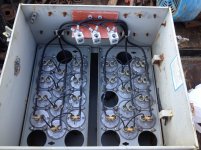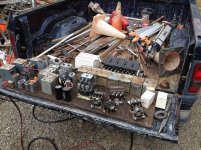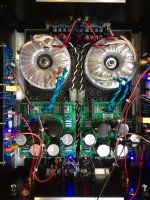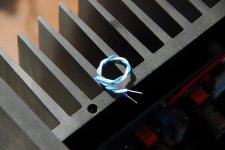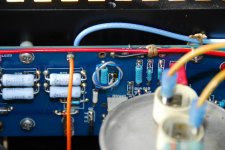Following the old American adage...
"Some is good, more is better, too much is just right." How about this for an outboard cap bank? 😀🙄
These are 60uF @ 600V....will have to pull out a couple to try them. And I have others as well. This was last years project designing a rotary phase converter for a lathe.
Cheers
"Some is good, more is better, too much is just right." How about this for an outboard cap bank? 😀🙄
These are 60uF @ 600V....will have to pull out a couple to try them. And I have others as well. This was last years project designing a rotary phase converter for a lathe.
Cheers
Attachments
^ That is a proper working man's pickup truck!
That was my workbench for the last 15 years, until I built the 832 sq' shop last year...just getting it setup now. 30 years of collecting parts to setup on shelves now...can hardly wait to see what treasures I have forgotten about. I know I have 2 flats of 2SJ49 and 2SK134...too bad they are out of vogue now. 🙄
I'll report back on the sonic differences with the oil filled caps tonight.
Cheers
those Hitachi aren't out of vogue
(special) parts aren't important as special idea** is
so , thinking just in lieu of today's fascinations is ...... funny
in the end , they're very decent pentodes 🙂
**luckily , we have Mithrandir around for that
🙂
(special) parts aren't important as special idea** is
so , thinking just in lieu of today's fascinations is ...... funny
in the end , they're very decent pentodes 🙂
**luckily , we have Mithrandir around for that
🙂
I have a stash of matched Hitachi lateral Mosfets that were pulled from a few working Hafler amplifiers. I've been saving them to build a class A amplifier such as described in Gyrator loaded Son of ZV9/F3.
I'm sure there are other good uses for these old devices. More recently I've considered substituting them for the 2SJ313 and 2SK2013 that are apparently used in the XA25.
I'm sure there are other good uses for these old devices. More recently I've considered substituting them for the 2SJ313 and 2SK2013 that are apparently used in the XA25.
I have now had a couple of good listening sessions with the AJ, and am looking for some guidance for tweaking this fine amp, from those who have actually fine tuned this....
My son who has much younger ears than I, and who is an accomplished drummer and music producer, listened for a few hours to 3 different amps, ones I have mentioned before, and I trust his ears and he pretty much concurred with what I thought in the first session a few days ago.
I won't detail the other amps but will describe what we heard in the AJ, and hope that a few tweaks will bring it around.
He noticed that the high hats had some sibilance, he couldn't hear all the nuances of the sticks hitting the cymbals, I found the midrange just a touch forward, almost a bloom, overall freq response was great, bottom extension was fine, maybe lacked a bit of space around the instruments, and perhaps a little lacking in depth. The amp that just did it all was the big 805 SET triode monster at 100lbs, driven by 6SN7 and 300B.
I sure would like to make the Aleph sound like that as I really don't like having 1000VDC sitting out for the cat to taste, and it takes up a lot of floor space in our small home. 🙄
I installed the 2 Aerovox oil filled run caps today, it may have helped the little bit of space around the instruments, but I still know there should be more out of this amp.
Things mentioned by others but haven't changed yet...
5pF cap, ditch the silver micas
Eliminate the Wimas, not sure why?
Could the fact that I am using a pair of IRFP150s instead of 4 IRFP240s make a difference?
And another thought came to me today...how important is the absolute temp of the amp to sonic qualities? Everyone says let the amp warm up before you listen, well, has anyone measured temp vs audio quality to see if there is a sweet spot? Today I put a couple of 1/4 speed 4.5" fans on it to keep it under control as it is on 24/7. HS temp is now 50C, chassis about 35C. If the heat sinks are too cool, ie FET junction temps aren't hot enough, will that affect the sound? I'm just throwing out my random physics thought here for discussion.
Look forward to your thoughts.
Cheers
My son who has much younger ears than I, and who is an accomplished drummer and music producer, listened for a few hours to 3 different amps, ones I have mentioned before, and I trust his ears and he pretty much concurred with what I thought in the first session a few days ago.
I won't detail the other amps but will describe what we heard in the AJ, and hope that a few tweaks will bring it around.
He noticed that the high hats had some sibilance, he couldn't hear all the nuances of the sticks hitting the cymbals, I found the midrange just a touch forward, almost a bloom, overall freq response was great, bottom extension was fine, maybe lacked a bit of space around the instruments, and perhaps a little lacking in depth. The amp that just did it all was the big 805 SET triode monster at 100lbs, driven by 6SN7 and 300B.
I sure would like to make the Aleph sound like that as I really don't like having 1000VDC sitting out for the cat to taste, and it takes up a lot of floor space in our small home. 🙄
I installed the 2 Aerovox oil filled run caps today, it may have helped the little bit of space around the instruments, but I still know there should be more out of this amp.
Things mentioned by others but haven't changed yet...
5pF cap, ditch the silver micas
Eliminate the Wimas, not sure why?
Could the fact that I am using a pair of IRFP150s instead of 4 IRFP240s make a difference?
And another thought came to me today...how important is the absolute temp of the amp to sonic qualities? Everyone says let the amp warm up before you listen, well, has anyone measured temp vs audio quality to see if there is a sweet spot? Today I put a couple of 1/4 speed 4.5" fans on it to keep it under control as it is on 24/7. HS temp is now 50C, chassis about 35C. If the heat sinks are too cool, ie FET junction temps aren't hot enough, will that affect the sound? I'm just throwing out my random physics thought here for discussion.
Look forward to your thoughts.
Cheers
Back when I ran Altec 604s (time-aligned version via the UREI 813A monitors) I found they were extremely sensitive to the front end and even to the amplification. They sounded better with a little roll-off on the highs, a mellower front end - vacuum tubes in general! Horn drivers have their plus and minuses for sure.
With more pedestrian KEF R500s, I'm extremely satisfied with my current system:
Ortofon 2M Bronze->Thorens TD309 turntable -> Classe 5 preamp -> Aleph J
The sound is between the big dynamics of the UREIs and the soundstaging depth of my departed Magnepan 1.6QRs.
I know the idea of break-in is contentious but in my experience the Aleph J really settled in after a few weeks of playing. Initially it was forward sounding, a little flat and the treble was just strange.
Now - and perhaps this is just from constant exposure - you could probably convince me, if the amp was behind a screen, that I'm listening to a tube amp but with better controlled bass.
With more pedestrian KEF R500s, I'm extremely satisfied with my current system:
Ortofon 2M Bronze->Thorens TD309 turntable -> Classe 5 preamp -> Aleph J
The sound is between the big dynamics of the UREIs and the soundstaging depth of my departed Magnepan 1.6QRs.
I know the idea of break-in is contentious but in my experience the Aleph J really settled in after a few weeks of playing. Initially it was forward sounding, a little flat and the treble was just strange.
Now - and perhaps this is just from constant exposure - you could probably convince me, if the amp was behind a screen, that I'm listening to a tube amp but with better controlled bass.
I have now had a couple of good listening sessions with the AJ, and am looking for some guidance for tweaking this fine amp, from those who have actually fine tuned this....
My Alephs don't have the problems you mentioned, so there must be ways to fix them 😉
Here are some thoughts:
Power supply: CRC filters are good. CLC filters are better. Two for each audio channel (one positive rail, one negative rail). If you think you have your Cs, Rs and Ls large enough, think again. What you hear is the power supply with some audio modulation by the amplifier 😀
Audio circuit:
* What's the bias current?
* What caps did you use in the Aleph source? Did you bypass the electrolytics with a film/foil cap? ZM says that 1 uF MKC caps make good bypass caps for this.
The IRFP150 parts are fine. A single IRFP150 is certainly easier to use a than parallel IRFP240. If you want something better, I can recommend the SJEP120R100, which are more difficult to find than the IRFP stuff.
My Aleph J remains almost completely stock as far as the channel boards are concerned. The little bit I did was use a higher precision 10V zener diode in the current source above the input differential pair, and a 25 uF aluminum organic polymer cap in that circuit at C4. Resistor values were adjusted to keep the standard bias current through the diff pair. I used a Nichicon FG series cap at C2 and an Elna Silmic II at C3. That was it.
My improvements to to the build pretty much began and ended with the power supply. After using a single shared PSU in my M2x, with the store PSU board fully populated with 22,000 uF caps, I put greater effort from the beginning into the Aleph J. Making use of some boards available in a group buy at the time, I built a dual-mono supply with CRCRC filtering, starting from pair of Antek 300VA, 20V transformers. All of the capacitors were 27,000 uF. I chose high current capacity KEMET caps right after the LVB2560 bridges, and Nichicon KS series at the final stage.
I have made a point of recommending dual-mono power supplies in various threads for FW clone builds since then. The difference between a shared PSU and dual-mono accounts for the majority of improvements across the board, particularly in the areas where you have suspected your Aleph J may have room to sound better. I have also found that care in choosing PSU capacitors yields benefits as well. For screw terminal caps, I recommend the KEMET ALS70 series; more specifically the 36,000 uF, 40V values as drop in replacements for your current PSU. If you choose to go with a CRCRC build with screw terminal caps, then the 24,000 uF, 40V values would also be a good choice.
My improvements to to the build pretty much began and ended with the power supply. After using a single shared PSU in my M2x, with the store PSU board fully populated with 22,000 uF caps, I put greater effort from the beginning into the Aleph J. Making use of some boards available in a group buy at the time, I built a dual-mono supply with CRCRC filtering, starting from pair of Antek 300VA, 20V transformers. All of the capacitors were 27,000 uF. I chose high current capacity KEMET caps right after the LVB2560 bridges, and Nichicon KS series at the final stage.
I have made a point of recommending dual-mono power supplies in various threads for FW clone builds since then. The difference between a shared PSU and dual-mono accounts for the majority of improvements across the board, particularly in the areas where you have suspected your Aleph J may have room to sound better. I have also found that care in choosing PSU capacitors yields benefits as well. For screw terminal caps, I recommend the KEMET ALS70 series; more specifically the 36,000 uF, 40V values as drop in replacements for your current PSU. If you choose to go with a CRCRC build with screw terminal caps, then the 24,000 uF, 40V values would also be a good choice.
1.9AAudio circuit:
* What's the bias current?
* What caps did you use in the Aleph source? Did you bypass the electrolytics with a film/foil cap? ZM says that 1 uF MKC caps make good bypass caps for this.
SILMIC II bypassed with WIMA MKP per the BOM.
I can recommend the SJEP120R100, which are more difficult to find than the IRFP stuff.
I'll take 12 please. 😀
TungstenAudio, my PS consists of 27,000uF caps x 4 bypassed with several caps PP 1uF, Polycarbinate 10uF and .1uF Polystyrene, and now the motor run caps 60uF. I contemplated dual xfmrs when I built this but decided I didn't have the room in this chassis to support 8 caps for CRC let alone 12 for CRCRC so unfortunately for this build, it will remain shared supply.
I'll continue to gather suggestions and let it burn in for another week or so before I tear it apart again. Maybe it will improve over time.
Thanks all.
Cheers
My Aleph J remains almost completely stock as far as the channel boards are concerned. The little bit I did was use a higher precision 10V zener diode in the current source above the input differential pair, and a 25 uF aluminum organic polymer cap in that circuit at C4. Resistor values were adjusted to keep the standard bias current through the diff pair. I used a Nichicon FG series cap at C2 and an Elna Silmic II at C3. That was it.
My improvements to to the build pretty much began and ended with the power supply. After using a single shared PSU in my M2x, with the store PSU board fully populated with 22,000 uF caps, I put greater effort from the beginning into the Aleph J. Making use of some boards available in a group buy at the time, I built a dual-mono supply with CRCRC filtering, starting from pair of Antek 300VA, 20V transformers. All of the capacitors were 27,000 uF. I chose high current capacity KEMET caps right after the LVB2560 bridges, and Nichicon KS series at the final stage.
I have made a point of recommending dual-mono power supplies in various threads for FW clone builds since then. The difference between a shared PSU and dual-mono accounts for the majority of improvements across the board, particularly in the areas where you have suspected your Aleph J may have room to sound better. I have also found that care in choosing PSU capacitors yields benefits as well. For screw terminal caps, I recommend the KEMET ALS70 series; more specifically the 36,000 uF, 40V values as drop in replacements for your current PSU. If you choose to go with a CRCRC build with screw terminal caps, then the 24,000 uF, 40V values would also be a good choice.
I started my AJ out with a shared PS, then went to dual mono and I concur with tungsten's assessment.
https://www.diyaudio.com/forums/pow...-illustrated-build-guide-107.html#post5999376
All components from the build guide BOM in the same thread.
5pF cap, ditch the silver micas
Curious if the suggestion was to ditch for another value, ditch all together, or ditch for a coiled wire?
I’ll echo the comments about dual mono being beneficial for AJ. I ran the stock PSU (diya board) for a good while and just recently stacked a second board and another 300VA 20V trafo in my chassis. Better separation, bass control, overall dynamics and control, etc in my application.
Curious if the suggestion was to ditch for another value, ditch all together, or ditch for a coiled wire?
Check out post 4777 for 5pF cap details.
Thanks for confirming with all the others, 2 supplies are better than one. 🙁
I'm going to gather all the parts needed to make the mods and probably tackle it next weekend. Shouldn't take too long as I have everything here. My one concern is my smaller xfmrs are 24VAC not 20VAC, so there will be some more heat to deal with, maybe a water cooled Aleph. 😱
Cheers
Check out post 4777 for 5pF cap details.
Thanks for confirming with all the others, 2 supplies are better than one. 🙁
I'm going to gather all the parts needed to make the mods and probably tackle it next weekend. Shouldn't take too long as I have everything here. My one concern is my smaller xfmrs are 24VAC not 20VAC, so there will be some more heat to deal with, maybe a water cooled Aleph. 😱
Cheers
Nice! While I think the dual mono does offer a marked improvement, the AJ with regular supply is still a really special amp. If one is not a big fan of the amp with regular PSU, I wouldn’t expect the dual mono supply to change their mind.
Building an Aleph J is as much a journey as a final destination. I considered mine a moving meditation, as well as a learning process.
As far as the 5 pF cap goes, there are a couple alternatives. The ceramic version would be C0G, 50V (old NPO designation). Polystyrene or polypropylene would be preferred for film. You can also use a pair of 10 pF caps in series if the 5 pF value is difficult to find. I haven't tried twisted wire, but that's not a bad idea if you have a scope to determine when you have the right length. Ideally it would be 30 ga. teflon wire-wrap wire. See the old Zen V4 article. Nelson recommends a length of about 1.5 inches of twisted wire-wrap wire to get about 5 pF.
As far as the 5 pF cap goes, there are a couple alternatives. The ceramic version would be C0G, 50V (old NPO designation). Polystyrene or polypropylene would be preferred for film. You can also use a pair of 10 pF caps in series if the 5 pF value is difficult to find. I haven't tried twisted wire, but that's not a bad idea if you have a scope to determine when you have the right length. Ideally it would be 30 ga. teflon wire-wrap wire. See the old Zen V4 article. Nelson recommends a length of about 1.5 inches of twisted wire-wrap wire to get about 5 pF.
5pF cap, ditch the silver micas
Curious if the suggestion was to ditch for another value, ditch all together, or ditch for a coiled wire?
And here is my version of the Teflon 5pF cap made from wire wrap wire that I have had for about 30 years. 🙄
More listening tonight.
I actually spent another couple of hours listening last night (before the cap change) and found myself thinking, "stop comparing to other amps, just listen to the damn music and be happy you have a great sounding amp that makes you happy", which I did, so I think I'll park major changes to this for now, like dual mono supplies and just live with it for a while and let it break in properly, then decide on what to do then.
Cheers
Attachments
Theory of Relativity +/-3db
Right on
Ya I came up with that back in the 70's when I was a bit of a science nerd, and all the stereo gear specs seemed to have that disclaimer
+/- 3dB. 🙄
Finally decided I needed a signature. Glad you like it. 😉
Cheers
Last edited:
- Home
- Amplifiers
- Pass Labs
- Aleph J illustrated build guide
